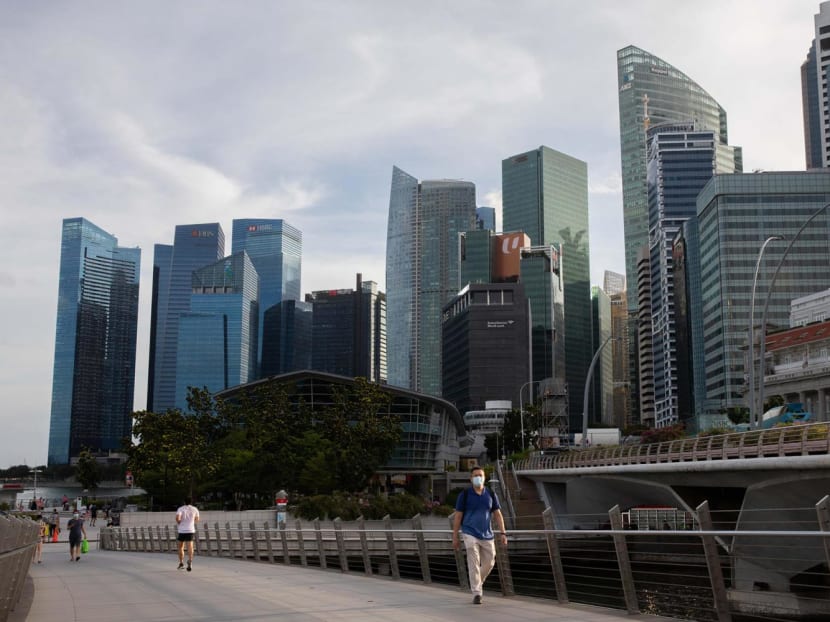Singapore’s core inflation rises to 3.3% in December, averaged 4.2% for 2023
SINGAPORE — Singapore’s core inflation rose slightly to 3.3 per cent year-on-year in December last year, official data showed on Tuesday (Jan 23).

A view of Singapore's Central Business District.

This audio is AI-generated.
SINGAPORE — Singapore’s core inflation rose slightly to 3.3 per cent year-on-year in December last year, official data showed on Tuesday (Jan 23).
It edged up from 3.2 per cent year-on-year in November due to higher services inflation, the Monetary Authority of Singapore (MAS) and the Ministry of Trade and Industry (MTI) said.
Core inflation, which excludes accommodation and private transport costs, had risen to 5.5 per cent in January and February last year, a 14-year high, before trending downwards. It fell to 3 per cent in September, the lowest since March 2022.
For the whole of 2023, core inflation averaged 4.2 per cent, higher than 4.1 per cent in 2022.
Meanwhile, the headline consumer price index, or overall inflation, was 3.7 per cent in December, higher than 3.6 per cent in November.
This reflected a faster pace of increase in private transport costs, alongside the pickup in services inflation, said MAS and MTI.
Overall inflation came in at 4.8 per cent, down from 6.1 per cent the previous year.
Inflation rates in 2023 were impacted by the increase in the GST rate to 8 per cent, the authorities said.
SECTORS
Services inflation increased to 3.9 per cent in December from 3.5 per cent in November, as holiday expenses rose at a faster pace. Airfares, however, posted a smaller decline. At the same time, point-to-point transport services fees and bus and train fares increased more strongly.
Private transport inflation rose to 5.0 per cent in December from 4.2 per cent in November, driven by larger increases in the prices of cars and petrol.
Retail and other goods inflation inched up to 1.1 per cent in December, as the cost of household durables rose and the prices of personal care goods increased more steeply.
Electricity and gas inflation eased to 1.3 per cent in December alongside a smaller increase in electricity costs.
Food inflation fell to 3.7 per cent in December as the prices of non-cooked food rose at a more gradual pace.
Accommodation inflation was unchanged as housing rents rose at a steady pace.
OUTLOOK
In 2024, core inflation is projected to average 2.5 per cent to 3.5 per cent. Excluding the transitory effects of the 1 percentage point increase in the GST rate to 9 per cent, core inflation is expected to come in at 1.5 per cent to 2.5 per cent.
Core inflation is expected to be affected by increases in the GST rate and increases in bus and train fares and electricity and gas tariffs in early 2024, said MAS and MTI.
“However, core inflation should resume a gradual moderating trend over the rest of the year, as import cost pressures decline and tightness in the domestic labour market eases.”
Global crude oil prices fell in the last quarter of 2023 and are expected to stabilise at around current levels.
Meanwhile, global prices for most food commodities, as well as intermediate and final manufactured goods, have continued to decline.
Prices of services associated with overseas leisure travel are also expected to moderate over the course of 2024 as supply conditions in international hospitality industries improve.
“These factors, alongside the stronger S$ trade-weighted exchange rate, should continue to temper Singapore’s imported inflation in the quarters ahead,” said MAS and MTI.
Locally, unit labour costs are expected to rise at a slower pace in tandem with the gradually cooling labour market. Businesses are likely to continue passing through higher labour costs to consumer prices, but at a more gradual pace.
COE premiums have been volatile notwithstanding further increases in the COE quota since November 2023.
“Upside risks to inflation remain, including from fresh shocks to global energy and shipping costs due to geopolitical conflicts, higher food commodity prices from adverse weather events, as well as more persistent-than-expected tightness in the domestic labour market,” MAS and MTI said.
“At the same time, an unexpected weakening in the global economy could induce a faster easing of cost and price pressures.” CNA
For more reports like this, visit cna.asia.








